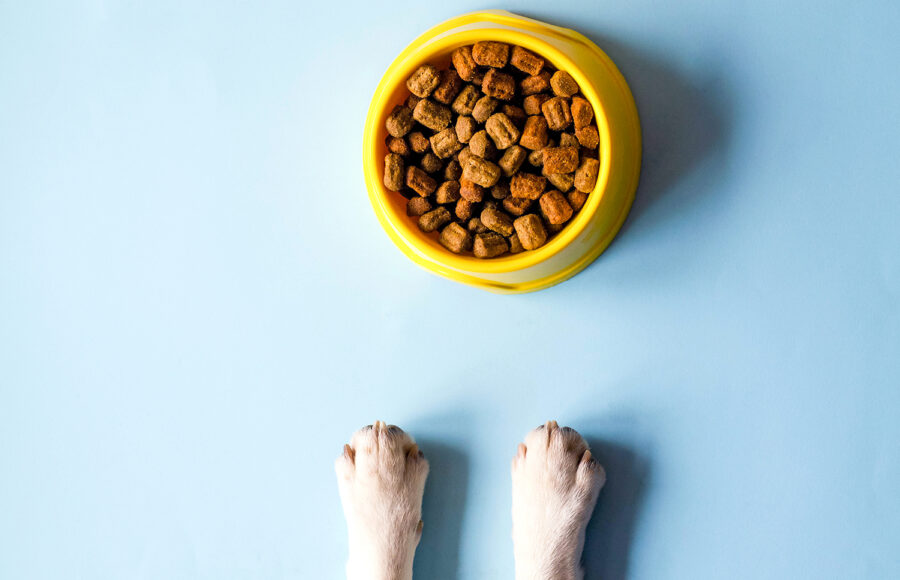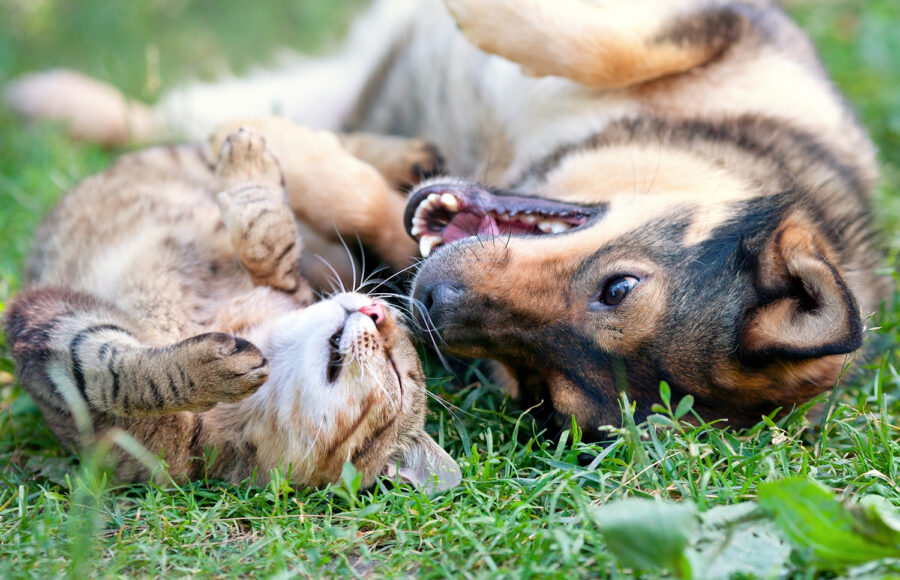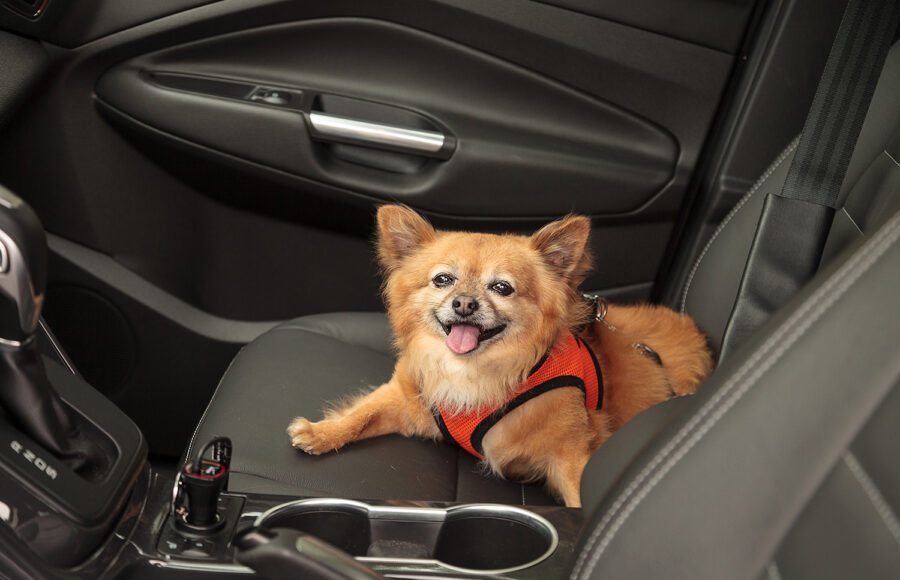
Nutrition and Exercise Matter
An estimated 52.7% of dogs and 57.9% cats in the United States are overweight or obese. Many people face the same issue, and the AVMA encourages pet owners to get regular exercise—with their pets! This improves cardiovascular health, helps both pets and people maintain a healthy weight, supports good mental health for both owner and pet, and strengthens the human-animal bond.
Walking is healthy for you and your dog. Not only is it physical activity, but it’s mental stimulation for your dog to smell, see and hear beyond the limits of your yard. Walking helps preserve your pet’s muscle tone and joint movement. If your pet is overweight or obese, walking can be a great way to shed those extra pounds.
The following tips can help you design a safe walking program for your dog…or even for your cat. (Yes, it is possible to train a cat to accept a harness and go for walks!)
-
Consult your veterinarian before starting any new exercise program with your pet. You need to make sure your pet is healthy enough for the exercise you plan.
-
Train your dog to behave on a leash, and seek help to address any behavioral problems.
-
Begin with short, frequent walks, and take frequent rests as needed.
-
If your pet seems to just want to go back home, try driving to a nearby park or less familiar area for your walks.
-
Remember that walks are also a means for your dog to enjoy his/her environment; allow your dog to take “sniff breaks” within reason.
-
Build gradually to one or more 15 minutes periods of brisk walking, then allow for cool-down time and recovery.
-
Avoid walks during the hottest parts of the day during warmer weather. Learn the signs of heat stress (Your veterinarian can teach you!) so you can recognize and address any problems that occur.
-
During warm, sunny weather, avoid hot surfaces – such as asphalt – that can burn your pet’s feet.
-
Avoid walks during the coldest parts of the day during cold weather, based on your pet’s cold tolerance. Learn to recognize signs of frostbite and hypothermia so you can address any problems that occur.
-
Walk on safe footing to avoid slips, falls or injuries.
-
Avoid deep sand or similar footing because it can cause fatigue and injuries.
-
If your pet shows signs of lameness, difficulty breathing, or seems to tire quickly, consult your veterinarian.
-
Obey leash laws, and always clean up after your dog.
Starting an exercise program for your pet
You’ve probably seen the warnings on fitness equipment that instruct you to consult your physician before starting an exercise program. The same applies to your pet, for good reason; it’s best to make sure that your pet is healthy enough to begin an exercise program and that the program is tailored to fit your pet’s health needs. Not sure where to start with your pet’s exercise program? Start with your veterinarian! In addition to walking, there are other opportunities for exercise programs that you can do together with your pet.
If your pet is recovering from injuries, talk to your veterinarian about exercise options (water treadmill sessions, swimming, etc.) that provide no- or low-impact exercise and can be used in the short term and/or incorporated into your pet’s exercise regimen.
How do I know if my pet’s weight is healthy?
First and foremost, have an honest conversation with your veterinarian about your pet’s weight. Your veterinarian can assess your pet’s weight and overall health and make recommendations regarding your pet’s weight, diet and exercise. Your veterinarian can also teach you to assess your pet’s body condition by observing your pet’s body shape and feeling certain parts of your pet’s body. A healthy weight isn’t simply a number on a scale; it’s about healthy body composition.

What are the benefits of keeping my pet at a healthy weight?
Keeping your pet at a healthy weight lowers his/her risk of diabetes, high blood pressure, respiratory disease, kidney disease, and some forms of cancer. It can also reduce the risks of injury to bones, joints and muscles that are associated with excess weight. If your pet has arthritis, keeping him/her at a healthy weight makes it easier to manage the discomfort associated with joint pain. Because excess weight can reduce your pet’s life expectancy by more than two years, keeping your pet trim gives them the best chance of a longer, healthier, and pain-free life.
How do I reduce my pet’s weight?
It’s probably no surprise, but there’s no one-size-fits-all approach or magic remedy to help your pet shed excess pounds. What works for one pet doesn’t necessarily work for another pet. Reaching and maintaining a healthy weight requires a commitment to a healthier lifestyle that achieves a balance between the calories consumed and the calories used by the body for normal functions and activity. Even a modest reduction in weight can significantly reduce your pet’s risk of life-threatening diseases.
In simplest terms, weight loss involves reducing your pet’s caloric intake and increasing their activity level to burn more calories. Be patient. It often takes longer to lose weight than it did for your pet to gain it.
Put your pet first
Working with your veterinarian, make an honest assessment of your pet’s health and weight. Does your pet have any medical problems that have been caused – or made worse – by excess weight? Is your pet’s weight putting him/her at a higher risk of disease or problems? Focus on what matters – your pet’s good health and long life.
It’s not about you
Your veterinarian’s honest assessment of your pet’s weight and health isn’t a judgment or assessment of your own weight or level of health or a statement about your ability to care for your pet. If you’re interested in a healthier lifestyle for yourself, consult your physician. Your veterinarian has your pet’s best interests in mind, and his/her recommendations are based on a commitment to your pet’s good health. It’s not about you; it’s about your pet’s health.
Make a family commitment
A commitment to reach and maintain a healthy weight for your pet requires a commitment from the entire family – a weight loss plan isn’t going to succeed if one family member sneaks your pet extra food. Remind your family that there are many ways other than food to demonstrate and express their love for your family pet.
Feed a nutritious and healthy diet
Eliminate table scraps and fattening, high-calorie treats; keep food treats to a minimum and focus on healthier food and treats; and don’t give into the sad, begging eyes. It may help to slow your pet’s food consumption by using a special bowl or food puzzle that makes it harder for them to gulp their food, or by using toys that dispense food in small amounts (be careful to keep the total daily amount of food within an acceptable amount). Smaller, more frequent feedings may also be of benefit to your pet’s health. Feed your pet a balanced, nutritious pet food. Consult with your veterinarian about the best food choice for your pet’s condition.
The recommended feeding amount printed on the pet food label might not be appropriate for your pet. Consult your veterinarian about the amount and frequency of feeding that’s right for your pet.
Set goals
Work with your veterinarian as a team to develop realistic goals for reducing your pet’s weight in a healthy manner. Rapid weight loss can result in serious health problems, so ask your veterinarian for recommendations for healthier eating and exercise that will produce a reasonable and safe rate of weight loss based on your pet’s overall health.
Make it fun
Being more active and living a healthier lifestyle benefits the entire family. Find activities you enjoy that can include your pet, and the journey will be more enjoyable for all of you.
Monitor and record progress
Once you’ve set reasonable goals to achieve and maintain your pet’s healthy weight, be sure to monitor and record your pet’s progress. As with all weight loss programs, there will be successes and there will be missteps. By monitoring and recording your pet’s progress, you can determine what’s working and what’s not effective, and make adjustments as needed to the program.
Maintaining your pet’s healthy weight gives your pet the best chance of living a healthier, longer life as a beloved member of your family. Talk to your veterinarian today about your pet’s weight.




